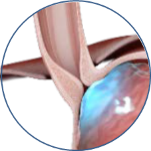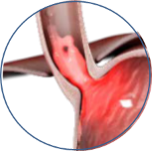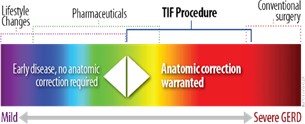What is GERD?
Gastroesophageal reflux disease (GERD) is a chronic condition caused by changes in the gastroesophageal valve (GEV) that allows acid to flow back from the stomach into the esophagus.
|

A healthy GEV opens to allow food and liquids to pass from the esophagus to the stomach and then closes to prevent stomach contents from refluxing back up into the esophagus.
|

A GERD GEV allows food and liquids to pass from the esophagus to the stomach and then remains open, thus enabling stomach contents to reflux back up into the esophagus.
|
GERD Prevalence and Impact
- GERD is the most common gastrointestinal-related diagnosis made by physicians during clinical visits in the U.S.
- It is estimated that pain and discomfort from acid reflux impacts over 80 million people at least once per month in the U.S.
- GERD can have a significant impact on a patient’s quality of life through persistent typical and atypical symptoms, inconsistent sleep patterns, dietary restrictions, additional health care costs and lost productivity from work.
See http://www.gerdhelp.com/gerd-references/ for more information.
GERD Symptoms
GERD can lead to both typical and atypical bothersome symptoms, which can vary from mild or moderate to severe depending on the individual. These symptoms can include:
|
Abdominal fullness or bloating
Asthma
Bad breath
Choking while eating or drinking
Chronic sore throat
Dental erosions or gum disease
Difficulty swallowing
Discomfort in ears and nose
Excessive salivation
Excessive throat clearing
Feeling of lump in throat
Frequent burping
|
Gas
Heartburn and chest pain
Laryngitis and hoarseness
Persistent dry cough
Regurgitation of food or sour liquid
Scratchy throat
Sensation of food stuck in the throat
Shortness of breath
Sour or bitter taste in the mouth
Sudden coughing episodes
Trouble sleeping
Wheezing
|
Diagnosing GERD
GERD can range in severity and can be a primary condition or a set of symptoms secondary to other chronic gastrointestinal conditions (e.g. nausea, vomiting, inflammatory bowel diseases). Determining the source of typical and/or atypical symptoms is critical to an appropriate treatment plan.
A physician can diagnose GERD based on the presentation of common symptoms, especially in patients with more mild cases. However, the diagnosis of more chronic GERD can be challenging given the variety of symptoms and manifestations.
Some tools a physician may use to diagnose GERD include patient history questionnaires, Esophagogastroduodenoscopy or Endoscopy (EGD), pH monitoring, Impedance, Upper GI Series (Barium Swallow or Esophagram) and Manometry.
See http://www.gerdhelp.com/gerd-references/ for more information.
Treating GERD
Treatment for GERD varies according to the severity of the symptoms and the individual. The goals of any GERD treatment regimen are symptom control, prevention of GERD-related complications, healing of esophagitis, and to help patients get back to life, free of the distraction and discomfort of GERD. Examples of how GERD can be treated include:
Dietary and lifestyle modifications
Changes in a patient’s diet and lifestyle may help mild GERD sufferers control infrequent symptoms.
Over-the-Counter and Prescribed Medications
Some medicines, such as H2 blockers, antacids, proton pump inhibitors (PPIs), and pro-motility drugs can provide symptom relief, but they do not treat the underlying anatomical problem or stop the disease from progressing. Evidence continues to mount on long-term use of PPIs. Long-term dependency is now associated with complications including negative impacts on the gastrointestinal system, bones, kidneys, heart, nutrient absorption, and shortened lifespan.
Anti-Reflux Surgery
 Chronic GERD sufferers may benefit from incisionless interventions and/or laparoscopic surgeries designed to reconstruct the anatomical components of the anti-reflux barrier. This approach restores the body’s normal defense against reflux. Conventional surgery has long been considered an effective solution to treating GERD; however, it frequently introduces negative side-effects such as difficulty swallowing (26%), bloating (36%) and increased flatulence (65%).
Chronic GERD sufferers may benefit from incisionless interventions and/or laparoscopic surgeries designed to reconstruct the anatomical components of the anti-reflux barrier. This approach restores the body’s normal defense against reflux. Conventional surgery has long been considered an effective solution to treating GERD; however, it frequently introduces negative side-effects such as difficulty swallowing (26%), bloating (36%) and increased flatulence (65%).
TIF Procedure for Reflux
See http://www.gerdhelp.com/gerd-references/ for more information